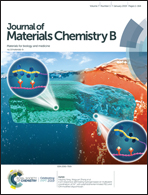Development of a cascade isothermal amplification approach for the sensitive detection of DNA methyltransferase†
Abstract
DNA methyltransferase (MTase) is an important epigenetic modification enzyme responsible for DNA methylation, and the dysregulation of DNA MTase activity is associated with various diseases in humans. Herein, we take advantage of the DNA lesion repair mechanism in vivo to develop a new fluorescence approach for the specific and sensitive detection of DNA methyltransferase (DNA MTase) on the basis of the DNA lesion repair-directed cascade isothermal amplification. Due to the high amplification efficiency of the uracil repair-mediated exponential isothermal amplification reaction (EXPAR), the efficient cleavage of endonuclease IV (Endo IV)-induced cyclic catalysis, and the low background signal caused by single uracil repair-mediated inhibition of nonspecific amplification, this approach exhibits high sensitivity with a detection limit of 0.014 U mL−1 for pure Dam MTase and 0.61 × 10−6 mg mL−1 for Dam MTase in E. coli cells and it can be further applied for the screening of DNA MTase inhibitors. More importantly, this approach can be applied to detect other DNA MTases by designing appropriate substrates, showing great potential in biomedical research and clinical diagnosis.



 Please wait while we load your content...
Please wait while we load your content...